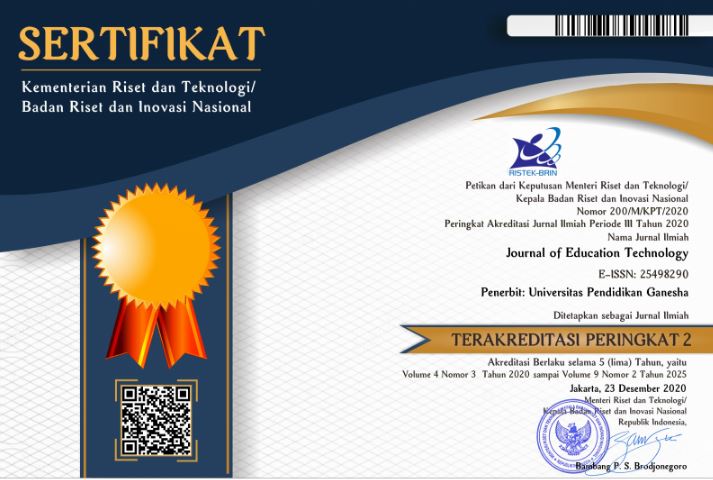The Effect of Problem Based Animated Learning Video on Science Content
DOI:
https://doi.org/10.23887/jet.v8i3.68999Kata Kunci:
Animated Video, IPA, Problem based learningAbstrak
The results of observations and preliminary research show that the background to several problems is the lack of use of creative learning media so that students are less active and less interested in learning so there is a lack of interaction between teachers and students. This is caused by teachers who still do not understand the use of technology in providing learning media for students. The solution to overcome this problem is the need to use creative and innovative learning media in schools to support the learning process. This development research aims to develop animated learning videos based on problem based learning. This research uses the ADDIE (analyze, design, development, implementation, and evaluation) model. Data collection used questionnaire and test methods. The test subjects for this research were learning content experts, learning design experts, learning media experts, individual tests, small group tests and students. The data analysis techniques used in this research are qualitative descriptive analysis techniques, quantitative descriptive analysis techniques, and t-test inferential statistics. This development research includes the results of: (1) design and development of learning videos, namely the stages of analysis, design, development, implementation and evaluation; (2) product trial results, namely: Assessment from learning design experts, namely 95% (very good), individual trial results, namely 87.2% (very good) and small group trial results, namely 80% (very good); (3) animated learning videos are effectively used to improve learning outcomes.
Diterbitkan
Cara Mengutip
Terbitan
Bagian
Lisensi
Hak Cipta (c) 2023 Made Krisna Astu Pradita, I Kadek Suartama

Artikel ini berlisensiCreative Commons Attribution-ShareAlike 4.0 International License.
Authors who publish with the Journal of Education Technology agree to the following terms:
- Authors retain copyright and grant the journal the right of first publication with the work simultaneously licensed under a Creative Commons Attribution License (CC BY-SA 4.0) that allows others to share the work with an acknowledgment of the work's authorship and initial publication in this journal.
- Authors are able to enter into separate, additional contractual arrangements for the non-exclusive distribution of the journal's published version of the work (e.g., post it to an institutional repository or publish it in a book), with an acknowledgment of its initial publication in this journal.
- Authors are permitted and encouraged to post their work online (e.g., in institutional repositories or on their website) prior to and during the submission process, as it can lead to productive exchanges, as well as earlier and greater citation of published work. (See The Effect of Open Access)

















